10+ SAMPLE Employer Safety Checklist
-
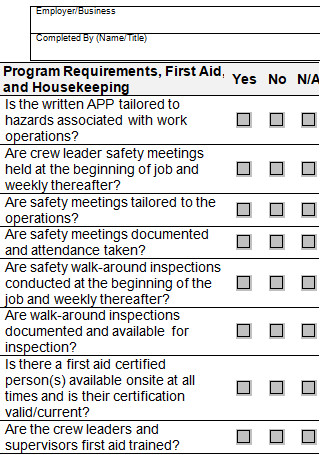
Employer Construction Safety Checklist
download now -
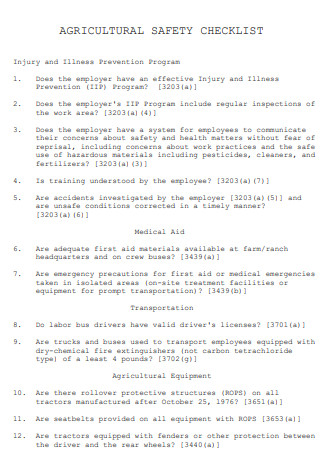
Agricultural Employer Safety Checklist
download now -
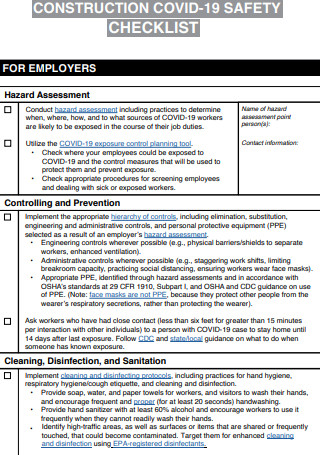
Construction Covid 19 Safety Checklist for Employer
download now -
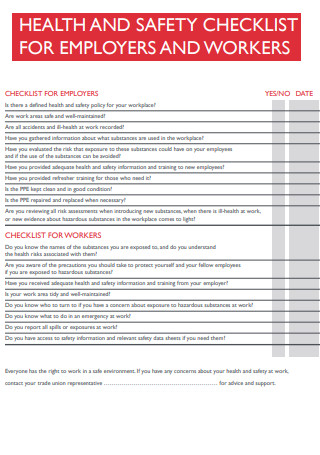
Employer Health And Safety Checklist
download now -

Employer Occupational Health And Safety Checklist
download now -
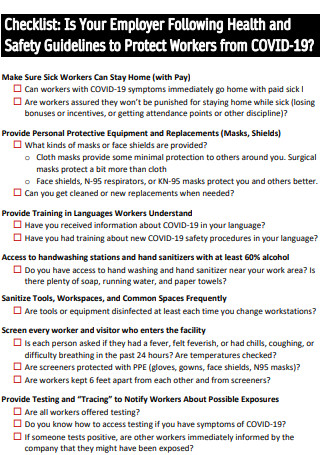
Sample Employer Safety Checklist
download now -
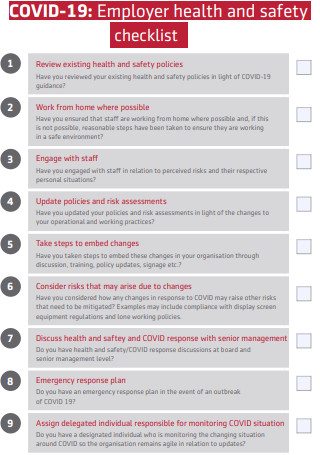
COVID 19 Employer Health And Safety Checklist
download now -
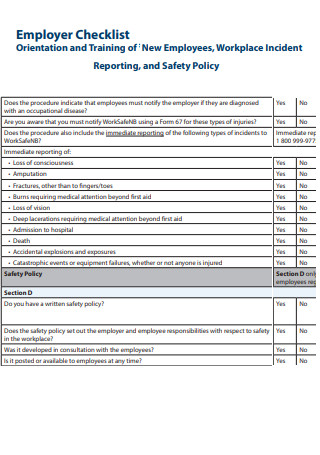
Employer Safety Policy Checklist
download now -
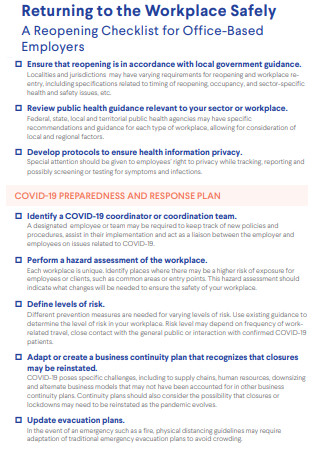
Employer Workplace Safety Checklist
download now -
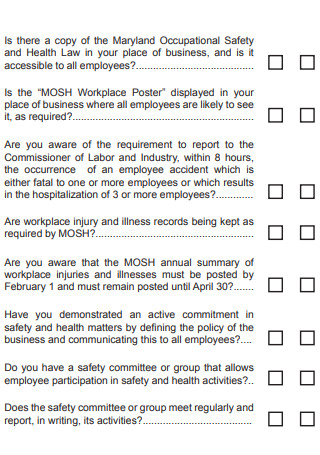
Employer Safety And Health Law Checklist
download now -
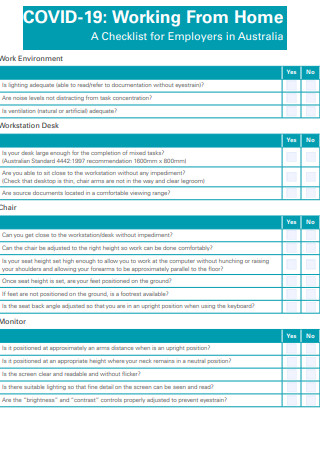
COVID 19 Working From Home Checklist for Employers
download now
FREE Employer Safety Checklist s to Download
10+ SAMPLE Employer Safety Checklist
What Is an Employer Safety Checklist?
Benefits of Workplace Safety
Types of Work Environment
How to Have a Safe & Positive Work Environment
FAQs
How do employers keep employees safe?
What is the golden rule in the workplace?
What is the importance of safety?
What Is an Employer Safety Checklist?
Safety checklists are used by safety officers, supervisors, and even employers to do essential safety inspections at work. It should include everything that goes into the job and everything that has to do with it on the job site. A checklist ensures the inspection goes smoothly by giving a guideline for each part and thing in the workplace that must be checked. Lists can help ensure the environment is safe and address any risks or hazards that could cause a costly accident or incident at work that could have been easily avoided if the employer had tried. With the help of a good safety checklist, safety inspectors should be able to check every work-related activity, operation, and part that could endanger the safety of everyone at the worksite. These checklists should also be made to fit the needs of a particular workplace and the way it is set up. Statistics show that unsafe actions cause 96 percent of injuries and illnesses.
Benefits of Workplace Safety
Why is workplace safety essential? Everyone in the sector desires to work in a safe and secure environment, so security in the workplace is paramount. The corporation has a legal and moral responsibility to ensure the safety of its employees. All sectors have safety concerns, but management should commit time to consider and strategize what safety safeguards are necessary in their company to ensure their employees are safe at all times. Also, management should ensure daily work conditions and comfort for all employees. So that management can take the same action based on the desired characteristics of employees. This helps them improve production, product quality, and much more.
Types of Work Environment
Your work environment is also affected by your ideals, personality, and the nature of your profession. Here are six sorts of work environments suited to various persons and occupations.
1. The conventional work environment
Conventional work environments are highly planned and organized and contain recurring tasks such as dealing with numbers and statistics. This workplace is characterized by routine, stability, tradition, and clearly defined procedures and norms. People who gravitate toward this environment tend to be neat, and organized, and prefer to follow instructions. This work environment is characterized by office work and regular hours.
2. The enterprising work environment
Activities such as persuasion, management, and sales are part of the entrepreneurial work environment centered on attaining organizational and financial objectives. Such a setting is characterized by competition, achievement, power, and money and may entail sales and management. Typically, individuals that succeed in this type of work atmosphere are gregarious, ambitious, and outspoken. This work setting encompasses corporate or business environments and the retail industry.
3. The social work environment
The social work setting is centered on people and consists of teaching, leading, healing, and comprehending individuals. As this social work environment involves significant social engagement, it attracts individuals who like social connections and are motivated to assist others. To succeed in such a setting, you must have outstanding communication, verbal, and interpersonal abilities. This may entail working in an office, conducting fieldwork, consulting with clients, instructing at a school or hospital, or working in a school or hospital.
4. The artistic work environment
The artistic workplace is non-systematic and prioritizes freedom of expression, creativity, aesthetics, imagination, and originality. This atmosphere is distinguished by its lack of structure, norms, and space. Typically, individuals drawn to this type of setting are unusual, free-spirited, intuitive, and independent. This atmosphere may incorporate theatrical performances, musical performances, design work, writing, and art creation.
5. The investigative environment
The inquisitive atmosphere emphasizes math and science and requires problem-solving, creativity, and abstract thought. This atmosphere is unstructured and promotes independence and freedom of thought and action, similar to the artistic work environment. People who perform well in such an environment are creative thinkers who prefer mental work to physical labor. This environment encompasses laboratory work, computer programming, statistical, scientific, and mathematical study, as well as archeology.
6. The realistic environment
The realistic setting emphasizes physical labor using tools, instruments, animals, plants, and working outdoors. People prefer working with their hands, concentrating on the present, and thriving in this setting. This setting encompasses mechanic, engineering, and technical positions that may involve working on-site, in workshops, or on-call.
How to Have a Safe & Positive Work Environment
A hostile work environment is where employees do not feel at ease and in which there is a lack of communication and transparency, making it difficult to do one’s duties. Bullying, discrimination, and intimidation are likely in hostile work situations. To assist those who wish to improve the atmosphere in your office, we have created a list of things you may do to increase optimism and safety.
Step 1: Create a forum for equitable and open discourse
Robust and high-performing workplaces should be conducive to open dialogue. Workshops and brainstorming sessions can be excellent ways to produce fresh, intriguing, and original ideas. The most extroverted and opinionated team members may dominate the conversation during group talks. To foster a safe and happy environment for the entire team, create a system in which everyone has the opportunity to express their idea or opinion. It can be disheartening to arrive at a meeting brimming with ideas, only to be talked over or to lack the guts to stand up when the time is right. Fortunately, technology is available to assist with these problems.
Step 2: Encourage your staff to express gratitude for one another
Actively demonstrating gratitude for one another and emphasizing how much you regard each individual’s contributions is a simple and gratifying way to foster a pleasant work atmosphere. This can be accomplished informally by encouraging employees to express gratitude to one another. Alternatively, this can be completed more controlled during team reflection sessions when everyone can provide comments.
Step 3: Comprehensive instruction and orientation
People feel at peace when they know what to do, how to do it, and whom to call for assistance. Helping individuals adjust to your company’s culture and methods of operation will take time, but you can make them feel at ease by welcoming them and guiding them through a planned onboarding procedure. The same holds for training; it can be incredibly depressing to be thrown into the deep end with little to no guidance, so take care that this does not occur to anyone. Many people battle with imposter syndrome when they begin a new career or join a new team. There are several ways to aid the afflicted, with training and onboarding playing a significant role. Not only can you assist people to feel more at ease in their environment, but you can also emphasize the support system they have nearby.
Step 4: Understand one another’s working methods
If you discover friction between team members, you should address it proactively. Typically, tensions between members stem from a lack of communication and a potential personality clash. To fight this, consider hosting a workshop or presentation in which each team member describes their preferred working methods, strengths, and flaws. This will assist your team gets to know one another and better grasping how to work together. Frequently, individuals whose personalities clash are unaware that their actions may provoke someone for a specific reason. A team with mutual understanding will positively affect your working environment. For everyone to feel as relaxed as possible, a meeting to clarify preferred working methods will help open lines of communication and establish limits.
Step 5: Celebrate team wins
A group that celebrates together remains united. You will realize that teamwork is responsible for most of your professional achievements. Celebrate victories in the workplace, regardless of their size. This will not only help people feel appreciated, but it will also help them recognize their significance to the organization. We’ve already discussed the importance of recognizing one another’s accomplishments, but it’s just as vital to acknowledge the group’s achievements. This activity will foster team spirit and help everyone understand how their contributions contribute to team objectives. Ask your group how they would like to celebrate their upcoming victory.
Step 6: Spend time together, rather than working
Your employees are people, not resources or hours of labor. Spend some time together engaging in a non-work-related activity. This can help revitalize the team and enable members to see one another beyond their job titles. If your team is relaxed and at ease in each other’s company, a happy and secure work atmosphere will result. This need not be an elaborate after-work gathering that involves weeks of organization and a significant expense. Consider getting lunch together once weekly; however, refrain from discussing work-related topics.
Step 7: Reflect together
Meditate on what you and your team have accomplished this week, what went well, what needs improvement, and what is ahead. Consider setting out 15 to 30 minutes at the end of the week for everyone to reflect on their own and the team’s performance. This can assist in identifying the week’s positives – whether goals and objectives were fulfilled, how new procedures functioned, and any potential roadblocks – and even look ahead to the following week. Not only is this a terrific opportunity to recap the week’s work, but it also helps highlight how things went, how the team can improve, and ease everyone into a well-deserved weekend rest.
FAQs
How do employers keep employees safe?
Ensure that staff have access to and use safe tools and equipment. Maintain this device properly. Use color codes, posters, labels, and signs to inform staff of potential dangers. Establish or revise operational procedures and disseminate them to staff to ensure safety and health regulations compliance.
What is the golden rule in the workplace?
The ‘Golden Rule’ entails recognizing that there are alternative ways of perceiving things and engaging with coworkers. Attempting to comprehend your team’s diverse cultural norms, expectations, and habits demonstrates respect, fosters trust, and develops long-term partnerships.
What is the importance of safety?
A safe and healthy workplace saves employees from injury and sickness. It can also cut injury/illness expenses, decrease absenteeism and employee turnover, improve productivity and quality, and boost employee morale. In other words, safety promotes commercial success. Moreover, protecting employees is the moral thing to do.
Safety is one of the most pressing problems, and managers and business owners must ensure that their staff work in a safe atmosphere. The management must ensure that they continue motivating and encouraging the person to keep them engaged in the job. There should be regular discussions concerning the office’s work and culture, so that management is aware of how they may simplify things for the comfort of their employees. In addition, the administration should provide prizes to express appreciation for the employees’ efforts to stimulate them. Thus, these simple measures will make your work extremely secure and safe for employees.
